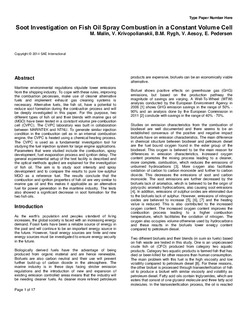| dc.contributor.author | Malin, Maximilian Christoph | |
| dc.contributor.author | Krivopolianskii, Vladimir | |
| dc.contributor.author | Rygh, Bjørn | |
| dc.contributor.author | Æsøy, Vilmar | |
| dc.contributor.author | Pedersen, Eilif | |
| dc.date.accessioned | 2018-01-09T10:22:59Z | |
| dc.date.available | 2018-01-09T10:22:59Z | |
| dc.date.created | 2015-09-16T15:54:28Z | |
| dc.date.issued | 2015 | |
| dc.identifier.citation | SAE International Journal of Fuels and Lubricants. 2015, 8 (3), 581-596. | nb_NO |
| dc.identifier.issn | 1946-3952 | |
| dc.identifier.uri | http://hdl.handle.net/11250/2476384 | |
| dc.description.abstract | Maritime environmental regulations stipulate lower emissions from the shipping industry. To cope with these rules, improving the combustion processes, make use of cleaner alternative fuels and implement exhaust gas cleaning systems is necessary. Alternative fuels, like fish oil, have a potential to reduce soot formation during the combustion process and will be deeply investigated in this paper. For this purpose, two different types of fish oil and their blends with marine gas oil (MGO) have been tested in a constant volume pre-combustion cell (CVPC). The CVPC laboratory was built in collaboration between MARINTEK and NTNU. To generate similar injection condition in the combustion cell as in an internal combustion engine, the CVPC is heated using a chemical heating process. The CVPC is used as a fundamental investigation tool for studying the fuel injection system for large engine applications. Parameters that were studied include the combustion, spray development, fuel evaporation process and ignition delay. The general experimental setup of the test facility is described and the optical methods applied are explained for the investigation of fish oil. The aim is to study soot intensity and spray development and to compare the results to pure low-sulphur MGO as a reference fuel. The results conclude that the combustion and ignition properties of fish oil are very similar to marine gas oil and this makes it applicable as an alternative fuel for power generation in the maritime industry. The tests also showed a significant decrease in soot formation for the two fish oils. | nb_NO |
| dc.language.iso | eng | nb_NO |
| dc.publisher | SAE International | nb_NO |
| dc.title | Soot Investigation on Fish Oil Spray Combustion in a Constant Volume Cell | nb_NO |
| dc.type | Journal article | nb_NO |
| dc.type | Peer reviewed | nb_NO |
| dc.description.version | acceptedVersion | nb_NO |
| dc.source.pagenumber | 581-596 | nb_NO |
| dc.source.volume | 8 | nb_NO |
| dc.source.journal | SAE International Journal of Fuels and Lubricants | nb_NO |
| dc.source.issue | 3 | nb_NO |
| dc.identifier.doi | 10.4271/2015-24-2479 | |
| dc.identifier.cristin | 1264780 | |
| dc.relation.project | Norges forskningsråd: 237917 | nb_NO |
| dc.description.localcode | Copyright © 2015 SAE International. This is the authors' accepted and reviewed manuscript of the article. | nb_NO |
| cristin.unitcode | 194,64,20,0 | |
| cristin.unitname | Institutt for marin teknikk | |
| cristin.ispublished | true | |
| cristin.fulltext | postprint | |
| cristin.qualitycode | 1 | |
